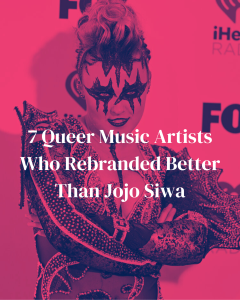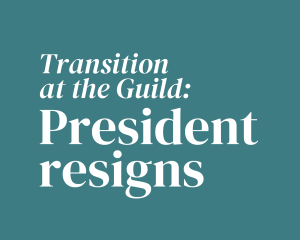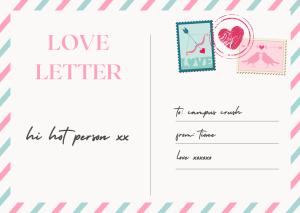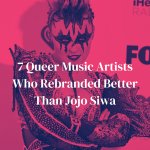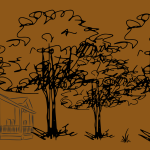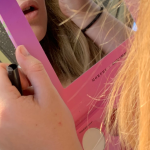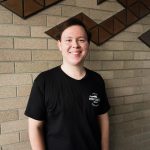
Woven acrylic hearts, embroidered lyrics, knitted sculptures, reconstructed glomesh. These are a few of my favourite things. And these are all things you will find at the QUT Art Museum right now. One of their current exhibitions, “I Wanna Be Adorned”, delves into the work of Troy-Anthony Baylis, a Brisbane-raised, Adelaide-based artist. Baylis is a QUT alum, whose work intertwines themes like music, pop culture, queerness, indigeneity, sexuality, and art history.
Keep reading for an exclusive interview with the artist, where we talk about his time as a young, queer art student, his love of the Minogue sisters, and, of course, his current exhibition.
Celeste: You’re a QUT alum, and you were an art student here in the 90s. What’s your fondest memory of being a student here at QUT?
Troy-Anthony: I suppose it probably goes all the way back to first year, which was 30 years ago. To paint a picture of what it was like, first year Visual Arts was actually in Meryvale Street in South Brisbane. It was a large sort of warehouse with a concrete slab – basically a big shed. And as a first year student, it was fantastic. I had just turned 17 and university was a total escape, a different world than my home life, which was troubling. To have that big shed and to go to art school, I very soon embraced who I was. It enabled me to do that…
It wasn’t until afterwards when I realised that Oh, actually, the world isn’t ready for me yet. It really wasn’t. Even in terms of what was on offer, what we could reference, what was in the academy, that kind of queer performativity stuff wasn’t there. But that innocence of just going into uni as a first year, and to just be able to feel comfortable to express myself in all sorts of ways, which might seem like seeking attention… it really was just freedom.
If you hadn’t gone to university, do you think you would have ended up where you are today? Or do you think that being in that creative space with like-minded people contributed a lot [to developing your creative process]?
I had really great support from other students. Ultimately, most people who went to art school didn’t continue on to become an artist. It’s a bit of a false dream, in a sense, but I did feel really supported by other people. It’s hard to know, but I don’t think I would have achieved what I have, if I had not gone to art school. I honestly don’t think I would be here at all.
Even experiencing the kindness of people who probably realised pretty early on that art wasn’t going to be a stable career for them. I think a lot of the really talented people from those early days knew that pretty quickly. And they soon applied what they learnt from art school into other areas, whether it was about being more social, or more tolerant about other people.
You use a lot of handmade craft techniques in your current exhibition, and in a lot of your work. Is that something that you’ve always loved?
I’ve always been doing it. We can call it ‘repetitive crafting’. I’m not sure if that’s made me into a more fidgety person than I was, or whether it’s been something to enable my constant need for making… I actually learnt some of those crafting techniques when I was much, much younger. It was that idea about being able to build something out of its own material. Take knitting wool, for example – it’s just this bit of wool, but watching something grow and building something from it, there is something really special about that.
Is there one technique or skill that took you a long time to learn that you’re really proud of? I was particularly taken by the Postcard series, where you used vintage faux-mesh pieced together to create tactile artworks.
I am proud of that work very much. It seems I’m not the only one because that’s the work that I was in The National [a biennial survey of contemporary Australian art] in Sydney a few years ago, and it literally became a turning point in my life, even though I have been working on it for a long time.
Some of those works take a year to make. I have been accumulating those [Glomesh] bags since art school. And 12 years ago, I finally realised this work is what I was going to do with them. I went to this free lecture which was around the breastplates awarded to Aboriginal people from Governor Macquarie and two governors after that. It was a way of making some sort of network or relationship between native peoples. Sometimes they were successful and sometimes it created terrible conflict within the community…
I guess all my work comes from asking, What is the problem and what can I do about it?
This was a way to, literally, mesh that together. It is an arduous process to make that work. It has to be very calculated. It’s very mathematical. Those works are really where the personal, the political, the art history ideas, all kind of came together. I probably am the most proud of those works.

I found I was very tempted to touch those artworks. It was hard to resist the urge to run my hand across it.
They’re essentially aluminum, or a different type of metal. They all have that kind of coating that makes them robust, so it wouldn’t have done any harm if you had touched them!
I’ve bought over 1000 of them by now. Those bags have probably got a lot of stories to tell. I get them hunting and gathering through thrift stores, sometimes from estate sales.
Not sure exactly what Glomesh is or its cultural significance? Click this link to find out more.
And then of course, I skin them and fillet them – I keep adding in all of the native tropes. My work always has that kind of humour, which really comes from that kind of queerness. A lot of Aboriginal art, certainly from my community, has that going for it anyway. I’ve just sort of amplified it. There is a festiveness, a highly charged part. Whether it’s about colours or design, it’s always there. I’ve just amplified it, sort of meshed queerness and indigeneity together.
Your work touches on so many different themes. You’ve already mentioned some of them – queerness and indigeneity – but there’s also pop culture and music and all these other themes mixed in. How do you balance all these ideas when you’re working on something new?
I think all of that is what’s natural to me…
There are all these stereotypes, like the idea that queer people like pop music but then don’t like heavy metal music. But I realised, actually, I like all those things. So, by putting that all into my art, I’m disrupting, in a sense, or confusing, what it’s like to be queer. I’m also confusing what it’s like to be an Aboriginal person. I mean, I don’t live on country. It’s a whole world out there.
Even our core identities are mixed and blurred; your identity isn’t only your sexuality, or your ethnicity… This idea is quite natural to me, because I am all of these different things. And I know that it might seem confusing sometimes, but combatting stereotypes gives a better, more holistic picture of what people are and what people are capable of.
“The more people in the mix, the more of a culture will be around. If you’ve got one record store in a suburb, people will go there for that, but if there’s several, well then, it’s a destination. It’s similar with relationships and subcultures, you have to keep sticking together, even if it doesn’t seem like you’re winning.”
I think a lot of people struggle with the desire to belong to a certain group. I don’t know if it’s our innately tribal nature as humans, but I do think it’s something young people, particularly, struggle with. Is that something you felt when you were young?
I think I felt myself, both internally and externally, having decisions made on my behalf. That I shouldn’t be included in this or that, because my work didn’t really fit into a particular category. I think wanting to belong is a very human thing, right? We often find it safe and helpful to create categories. Because if there was just chaos everywhere, it would be like ants out of the nest…
I think my core identifications and my core being are just being celebrated now. And they weren’t before. It’s been a slow burn that I’ve had to endure. Look at the trope about bringing down the master’s house. If you want to bring down the master’s house, it has to be slow. Because if you just knock it down, there’s nowhere to go…
It’s probably why I make work like I do, because it’s a slow burn… I feel hurt and inadequate and upset all the time. But the work allows me to be in control of what I’m doing and to make something that’s more permanent, that can endure and not play into a media cycle.

In your Instagram bio, you call yourself a KYLIEminologist and DANNIIminologist. What is it about the Minogue sisters that you love so much?
I was 11 years old when Locomotion was coming out, and it was pretty big. It was the biggest Australian selling song in the 80s, by an Australian artist. And at that time, it was disruptive to the music industry. I know earlier on we did have other manufactured aspects of pop music, like The Monkeys. But Australia and the world were like, this person doesn’t deserve to be a musician, this person doesn’t deserve to be in the charts.
I knew at the time that the sexuality that had been prescribed to me wasn’t a match… I don’t think Kylie came from a poor background, but she soon would have realised what it was like to have all these people seemingly against her. And she just continued to work. She’s so incredibly hard-working. She was an underdog, and I related to that underdog. Not surprisingly, a lot of queer people related as well. In hindsight, I don’t think she expected that, but she certainly leaned into it. And she educated herself about the queer community as much as you possibly could. She really deserves the accolades from the community that she gets, because she has worked so hard for them.
In this exhibition, there’s a lot of reference to music – lyrics, song titles, pop stars. Has music always been an important part of your artistic practice?
Always. In fact, I went to a school that specialised in music. At the last minute, I thought, No, I don’t want to go to the conservatory of music, I want to be an artist. I just needed to express myself on my own terms and I felt that visual arts [would allow me to do that].
Music, again it’s all culture. I was a fan of the visual-ness of music. Like a lot of people, I was a goth in the 90s. I also DJ’d at two gothic clubs in Brisbane as well, namely London Burning and Asylum. I would attend lots of different clubs as well… There were all different spaces where ethnicity, colour, costume, clothes, gender would all sort of mix. Music was quite a fertile space, which lots of people occupied. But for me, it was absolutely the best, safest place to be.
“I guess I’m much more mature now too, but I have no qualms in meeting anybody at all now. So, all that shyness [I felt as a young person], I still have it, but it’s not shyness protecting me from everything anymore. I’m a bit more confident in the story I have to tell. And it’s relatable. I’ve been so enriched by people’s kindness, and it’s reciprocated back.”
How does it feel to have your work exhibited at the QUT Art Museum?
Oh, it feels like an absolute homecoming! It’s been so good! I’ve been overwhelmed by the amount of people who have come to see it. I’ve been overwhelmed by the feedback. It’s enabled me to reconnect to a whole lot of people who probably hadn’t thought about me for a long time. I’ve had people who I went to college with, the very first year of university, who have reached out and they threw a party for me.
I don’t think I can over-emphasise that in that time [since the 90s], Brisbane was half the population that it is now. And culturally, I know there are still deficits here in there, but in the main, it’s just leaps and bounds – there’s a Paul Kelly reference for you – it’s leaps and bounds ahead of what it was before. I’m just amazed and it’s people who have done that.
I’m very proud to have had all my adolescence, my undergraduate degrees, my first post graduate degree at QUT. I’m incredibly proud of the population for making all of these societal and cultural changes [over the last few decades] and really stepping it up. Starting to remind some other places that they need to get a wriggle on and get with the program, because Queensland is really going places.

Do you have any advice for visual arts students or students who want to go into the arts?
Do it. Culture is always made by those who are in it. If you’ve got a passionate desire to be an artist, go for it. It is hard and you might not become a full-time artist, but whatever skills you get from whichever degree, you can transfer those skills into other areas. That creativity you will develop, that’s already in you, is translatable. So, remember that forever, really. Because any field that you choose is so competitive.
The second thing is work hard. You have to work hard. Maybe harder than others, in some ways, because the arts are underfunded. Even though Australia tries to say we celebrate the arts, we really don’t, it’s really about entertainment. And it’s a struggle, but if you believe in yourself, other people will believe it too.
Lastly, you’re not going to get along with absolutely everybody, but you can try and support one another. Tell those green-eyed monsters to rack off, because they’re not useful. You need all the support you can get, so keep those relationships going if you can, because you never know when you might need them. Even if it’s not financially, it’ll add to your sense of belonging. So, keep good relationships.
